Sustainable agricultural transition: what if we placed social impact at the heart of regenerative agriculture?
With the goal of transitioning to a sustainable and inclusive international food system, regenerative agriculture emerges as a powerful force for positive change. With a simplified goal of “giving more life than we take,” we obviously recognize the virtue of these strategies for the sustainability of soil quality and the environment. However, beyond its environmental merits, integrating social impact considerations into regenerative agriculture projects is crucial for fostering prosperous communities and building a more resilient and equitable future.
It is crucial to recognize that any transition to a sustainable and regenerative agricultural system cannot be accomplished without the inclusion and close collaboration of farmers themselves. The recent strikes and protests in France, highlighting the challenges faced by farmers, only underscore this reality. These events highlight the crucial importance of involving farmers in the design and implementation of sustainable agricultural policies and practices. Without their engagement and support, any transition to a more sustainable agricultural model risks remaining elusive. The voices of farmers must be heard, and their concerns taken into account to ensure an effective and equitable transition to a sustainable and regenerative agricultural system.
This approach must therefore go beyond mere agricultural practice to become a driver of sustainable change, for several fundamental reasons:
1. Improvement of Quality of Life
By focusing on social impact, regenerative agriculture projects directly improve the quality of life for residents. Food security through nutritious food and the creation of local jobs are concrete benefits. These improvements not only contribute to individual well-being but also strengthen community resilience as a whole.
Beyond just job creation, regenerative agriculture projects should aim to ensure that agricultural workers receive fair compensation that enables them to meet their essential needs such as housing, education, and healthcare. The adoption of the “Living Wage” (for farmworkers) or “Living Income” (for independent producers) as a reference underscores the commitment to genuine and meaningful improvement in the quality of life within communities. It is also these improved incomes and living conditions that will encourage younger generations to take over farms, thus making regenerative projects sustainable and durable. Changing practices presupposes a change in producers’ behavior. Therefore, they must see an interest in it and it must allow them to live better.
2. Deep Community Engagement
Integrating social impact into regenerative agriculture projects is equivalent to recognizing the essential role of local communities. This actively engages residents in decision-making processes, creating a sense of responsibility and ownership within the community. Regenerative agriculture thus becomes a collective project, shaped by local needs and values. Identifying the needs of local communities upstream and during the project’s deployment through a “bottom-up” approach is therefore essential for the sustainability of agricultural practices.
3. Empowerment of Local Actors
Regenerative agriculture becomes a catalyst for local empowerment, especially for small-scale farmers. By providing them with the knowledge and tools necessary, these projects offer farmers the opportunity to improve their practices, thereby increasing their economic independence. This creates lasting social impact by strengthening livelihoods at the local level.
4. Knowledge and Education Transfer
Integrating social impact into regenerative agriculture is not just a matter of agricultural practices but also of education. These projects provide a platform to educate farmers and the community about sustainable agricultural practices. This knowledge transfer creates a multiplier effect, encouraging deeper understanding and fostering a culture of environmental responsibility.
Don’t miss out on Kinome’sblatest updates by subscribing to our newsletter!
5. Preservation of Cultural Wealth
Like every project following a bottom-up methodology involving local communities, regenerative agriculture projects that integrate social impact also strive to preserve local cultural wealth. By harmonizing modern agricultural practices with traditional knowledge, these projects help maintain and celebrate local cultural heritage. This results in a synergy between agricultural progress and the preservation of traditions.
6. Social Justice and Equity
Integrating social impact considerations into regenerative agriculture responds to the imperative of social justice. It is crucial to ensure that the benefits of these projects are distributed equitably among different social strata and sub-communities. An essential dimension of social justice in regenerative agriculture projects is gender consideration. It is imperative to ensure gender equity, ensuring that women, who often play a central role in agriculture, also fully benefit from regenerative initiatives. This encompasses equitable access to resources, educational opportunities, and community decisions, thereby reinforcing diversity and equality of opportunity within the agricultural community. Promoting gender equity not only contributes to a more complete social justice but also to the long-term sustainability of regenerative agriculture projects.
7. Adaptation to Climate Change
By incorporating social elements, regenerative agriculture projects contribute to resilience against climate change. Creating a strong social infrastructure enables communities to better cope with environmental challenges, making these projects social shields against the impacts of climate change.
In summary, the importance of including social impact in regenerative agriculture projects lies in creating an ecosystem where adoption of environmentally friendly practices goes hand in hand with social flourishing. It is a holistic approach wich recognizes that sustainability can only be achieved through positive interaction between agriculture, the environment, and local society.
Don’t miss out on Kinome’sblatest updates by subscribing to our newsletter!



#agroforestry #impact #study #investment These articles may be of interest to you Context and issues 1.2.Tree Finance (now RRG Nature-Based...
With the goal of transitioning to a sustainable and inclusive international food system, regenerative agriculture emerges as a powerful force...
#cocoaculture Content Environmental and social issues in the cocoa sector Sustainable cocoa Cocoa varieties Study of PAPFor and WABILED projects...




